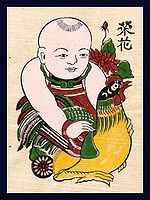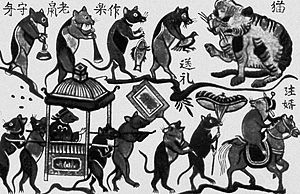- Dong Ho painting
-
Dong Ho painting (Vietnamese: Tranh Đông Hồ or Tranh làng Hồ), full name Dong Ho folk woodcut painting (Tranh khắc gỗ dân gian Đông Hồ) is a genre of Vietnamese woodcut paintings originated from Dong Ho village (làng Đông Hồ) in Bac Ninh Province, Vietnam. Using the traditional điệp paper and colours derived from nature, craftsmen print Dong Ho pictures of different themes from good luck wishes, historical figures to everyday activities and folk allegories. In the past, Dong Ho painting was an essential element of the Tết holiday in Vietnam; this tradition has gradually declined under the influence of modern types of painting and fake Dong Ho products. However, the art of making Dong Ho pictures is always considered a symbol of traditional culture and aesthetic value of Vietnam.
Contents
Themes
Dong Ho painting is considered a fine reflection of the traditional aesthetic value, social philosophies and humanitarian desires as spring approaches. The traditional themes of Dong Ho painting are good luck signs, historical figures, folk allegories, popular stories and social commentary. Elements of everyday life are well integrated in Dong Ho painting so that it can be used to express the thoughts and wishes of people.[1][2] Following is the table of main themes in Dong Ho paitings and exemplary pictures of each theme:[3]
Theme Pictures Spirit Ngũ sự, twelve signs of Chinese zodiac Good luck wishes Lợn đàn (corpulent pig with suckling piglets), Gà đàn (hen surrounded by chickens), Cá chép (carp) Mythical and historical figures Bà Triệu, Hai Bà Trưng, Quang Trung, Thánh Gióng Folk allegories and popular stories Truyện Kiều, Thạch Sanh, Thầy đồ Cóc (Confucian scholar in form of a toad), Đám cưới chuột (Rat's wedding with a watching cat) Social activities and commentaries Đánh ghen (Scene of jealousy), Hứng dừa (Scene of catching coconuts), Đấu vật (Scene of wrestling), Chăn trâu thổi sáo (Boy sitting on a buffalo and playing flute) the couplet Vinh hoa and Phú quý Because Dong Ho paintings are mainly bought and displayed on the occasion of Tết, contents of pictures are often humorous, optimist with many bright and powerful colours like red, yellow or white.[3] The most popular and well sold pictures of Dong Ho painting are Lợn đàn, Gà đàn and Chăn trâu thổi sáo which represent the wish for prosperity, happiness and luck in the new year.[3][4] Together with the illustration, a Dong Ho painting also has some Hán tự to literally describe the meaning of the picture. Sometimes Dong Ho pictures are shown in couplet or quartet to fully express the signification of the set, for example the Vinh hoa (Eminence) and the Phú quý (Prosperity and honour) should be taken in couple.[1] Besides, Dong Ho painting was once used as a medium to express the social concern of craftsmen through subtle social, political and cultural criticism. For example, before the World War I, Dong Ho villagers produced a set of four prints entitled Văn minh tiến bộ (The Progress of Civilization) in which the Westernization of the Vietnamese society was delicately criticized through the satiric portrayal of contemporary Vietnamese people dressing and behaving like French peole.[5] Some Dong Ho paintings became famous for their interesting themes like the picture Đám cưới chuột (Rat's wedding) which features a wedding march of rats with the rat bride and groom and other rat guests shaking before a big watchful cat. Inspiring from the special situation of the picture, Gạt Tàn Đầy, a Vietnamese rock band, wrote their popular song Đám cưới chuột,[6] the picture was even used as the scenario for a dog circus act of the National Circus Theatre.[7]
Images
Making
Colour Origin[4][1] Black Burnt bamboo leaves Green Cajuput leaves Blue Verdigris Amber Turpentine Red Powder of red gravels Yellow Aniseeds White Powder of egg shells Dong Ho painting is the exclusive product of the Dong Ho village, a craft village located on the left bank of the Đuống River in Bac Ninh Province, about 35 km from Hanoi.[4][1] Craftsmen in the village often produces their own raw materials for the making such as điệp paper and natural colours.[3]
In printing pictures, Dong Ho craftmen use a special type of paper named điệp paper (giấy điệp). Điệp paper is obtained in almost the same way as dó paper, the bark of dó tree, which normally is grown in Tuyen Quang Province, is soaked in water for months, then mixed with powders of seashells (sò điệp), which is the origin of the paper's name, and glutinous rice to make sheets of paper.[8] Thank to the element of seashell and glutinous rice, điệp paper possesses an exotic sparkling hard background and is able to conserve the durability of colours.[4][2] The colours of paint using in printing are refined from various kind of natural materials which are easily found in Vietnam. For instance, the red colour is taken from red gravel in Thiên Thai Mountain while the black comes from coal of burned bamboo leaves. In that way, Dong Ho painting can keep its colours for a long time.[9]
The last stage of making Dong Ho painting is printing, the woodblock is applied with paint and pressed on a sheet of paper like a stamp, the process is repeated with different colours until the craftsman is satisfied with the painting.[9] There are one woodcut for outline and several others for each colours printed, they are carefully engraved by hand so that the woodcuts can be preserved through generations.[2] The finished picture is covered with a layer of rice paste (hồ nếp) to strengthen the durability of its illustration and colours and afterwards dried under the sun.[10] In the past, to prepare for the Tết, craftsmen had to begin the process of making six or seven months ahead.[1]
History
According to the villagers, the making of Dong Ho painting was dated back to the 11th century during the reign of the Lý Dynasty while researchers propose that craftsmen began to print pictures in Dong Ho village during the rule of Lê Kính Tông (1600–1619) of the Lê Dynasty.[1] In the dynastic time, Dong Ho village is one of the few place which had the tradition of making folk painting, along with Hang Trong, Kim Hoang and Sinh village.[11] Originally, Dong Ho painting was made only with black-and-white prints of woodcut but from the 15th century, different colours were introduced by craftsmen in the village. As a village specialized in making woodcuts and paintings, almost all Dong Ho villagers were involved in the manufacture of paintings from carving the wood block, producing điệp papers, obtaining natural colours to creating new themes and printing.[3]
Traditionally, Dong Ho painting was an essential element in each Vietnamese family during the Tết holiday.[9][8] The colourful tone and optimist content of the image livened up the house and the picture was considered a good luck sign for the family in the new year, thus Dong Ho painting had other names like Tết painting (tranh Tết) or Spring painting (tranh Xuân).[1][2] Before 1945, there were over 150 families in Dong Ho village making pictures.[12] However, the tradition fades rapidly under the dominance of modern life in Vietnam and Dong Ho pictures gradually disappear in Vietnamese families during the Tết holiday. The principal buyer of Dong Ho painting today is tourists who are interested in traditional art, therefore the villagers cannot live on this production any more.[4] Dong Ho painting also has to face with the menace from fake pictures which are mass produced by printing machines.[13] As a result, there are only several households in Dong Ho village which still make pictures while the others switch to producing joss paper and votive paper objects (vàng mã).[4][10]
There are several efforts in order to preserve this traditional art. A Dong Ho painting center was established in 2008 by Nguyễn Đăng Chế, one of the few remaining experienced craftsmen of the village.[9][1] Some artists also try to adapt the element of Dong Ho painting in modern fine art such as using the technique of woodcut printing like Dong Ho craftsmen or drawing with the inspiration from Dong Ho pictures.[14][15][16] To honour this traditional art and propagate the beauty of Dong Ho painting, the Ministry of Post and Telecommunications of Vietnam issued in 2007 a set of commemorative stamps with the artwork in the style of traditional Dong Ho paintings such as Lợn đàn or Lợn Âm Dương.[17]
See also
- Hang Trong painting
- Kim Hoang painting
References
- ^ a b c d e f g h "Rooster woodprints crow in the new year". Vietnam News Agency. 2005-02-06. http://vietnamnews.vnagency.com.vn/showarticle.php?num=02ART060205.
- ^ a b c d "Tranh Đông Hồ" (in Vietnamese). Từ điển bách khoa toàn thư Việt Nam. http://dictionary.bachkhoatoanthu.gov.vn/default.aspx?param=1610aWQ9MTY1OCZncm91cGlkPSZraW5kPXN0YXJ0JmtleXdvcmQ9dA==&page=46.
- ^ a b c d e Discovery Channel (Firm) (2003). Vietnam - Insight guide. Langenscheidt Publishing Group. pp. 115–116. ISBN 9812349847.
- ^ a b c d e f "Where has the Dong Ho Painting village gone?". Vietnamnet.vn. 2007-02-22. http://english.vietnamnet.vn/lifestyle/2007/02/666050/.
- ^ Kathryn Robson, Jennifer Yee (2005). France and "Indochina": cultural representations. Lexington Books. p. 69. ISBN 0739108409.
- ^ Nguyễn Mạnh Hà (2008-02-10). "Một thập kỷ 'Đám cưới chuột'" (in Vietnamese). Tienphong.vn. http://www.tienphong.vn/Tianyon/Index.aspx?ArticleID=110407&ChannelID=7.
- ^ "Of mice and men... and cats and marriage". Vietnam News Agency. 2008-01-26. http://vietnamnews.vnagency.com.vn/showarticle.php?num=03CUL260108.
- ^ a b Sachs, Dana (2003). Two cakes fit for a king: folktales from Vietnam. University of Hawaii Press. pp. 15–16. ISBN 9780824826680.
- ^ a b c d "First Dong Ho folk painting centre inaugurated". Vietnamnet.vn. 2008-07-29. http://english.vietnamnet.vn/lifestyle/2008/07/796045/.
- ^ a b "Dong Ho loses painting tradition; switches to making paper objects". Vietnamnet.vn. 2008-01-29. http://english.vietnamnet.vn/lifestyle/2008/01/766493/.
- ^ "Odd paintings from shipwrecks". Vietnamnet.vn. 2009-03-24. http://english.vietnamnet.vn/reports/2009/03/837824/.
- ^ "Keeping an ancient art form alive". Vietnam News Agency. 2008-08-31. http://vietnamnews.vnagency.com.vn/showarticle.php?num=01INN310808.
- ^ "Countryside culture for city slickers". Vietnamnet.vn. 2009-07-08. http://english.vietnamnet.vn/lifestyle/2009/07/857142/.
- ^ "Le Phuong Dong wood-engraving painting exhibition". Vietnamnet.vn. 2006-11-13. http://english.vietnamnet.vn/lifestyle/2006/11/633106/.
- ^ "Folk art gets 21st-century interpretation". Vietnamnet.vn. 2009-06-24. http://english.vietnamnet.vn/Entertainment/2009/06/854718/.
- ^ "Exhibition features woodblock prints". Vietnam News Agency. 2006-11-22. http://vietnamnews.vnagency.com.vn/showarticle.php?num=01ART221106.
- ^ "In the pink for the Lunar New Year". Vietnam Women's Union. 2007-02-05. http://www.hoilhpn.org.vn/newsdetail.asp?CatId=131&NewsId=5561&lang=EN.
External links
- (Vietnamese) Official website of the Dong Ho painting company, one of the few private companies making and selling authentic Dong Ho painting
Categories:- Vietnamese art
- Vietnamese culture
- Bac Ninh Province
- Vietnamese painting
Wikimedia Foundation. 2010.











